Adani Inaugurates India's Vizhinjam Deepwater Container Terminal
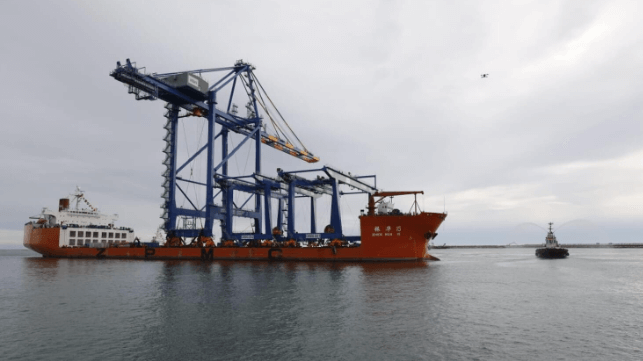
On Sunday, the heavy lift ship Zhen Hua 15 docked at India’s new Vizhinjam Port from China, laden with gigantic cargo handling cranes for the facility. The vessel’s maiden visit was celebrated across India as it marked the inauguration of Vizhinjam Port.
“A significant milestone has been completed as the heavy load cargo ship docked at Vizhinjam Seaport. Boasting container transshipment capabilities and proximity to major shipping routes, it’s a game-changer for Kerala’s infrastructure and development,” said Pinarayi Vijayan, Chief Minister of Kerala, as he welcomed the vessel on Sunday
As India’s first deep-water port, Vizhinjam is set to position India as a top global transshipment hub. Although the port’s construction was officially commissioned in 2016, the idea for the project was first mooted in the early 1990s.
The $925 million Vizhinjam Port is located in the southern tip of India in the State of Kerala. It is being developed under a public-private partnership, with the local state government providing funding together with the private partner Adani Ports and Logistics.
Despite being an economic power, poor ports infrastructure has been a major setback for India’s development ambitions. Of the fourteen major ports serving the country, most of them lack the necessary draft needed to accommodate mega-ships. This has been a disadvantage to India’s liner connectivity, as the large container vessels have been forced to skip the country for other attractive ports in Asia such as Singapore, Dubai and Colombo.
This is about to change with Vizhinjam boasting a natural channel that is as much as 24 meters (79 feet) deep. In addition, the port will have a capacity of one million teu in its first phase, and an additional 6.2 million teu to be added in the following phases, according to developer Adani Ports.
In its recent Maritime Transport Report 2023, UNCTAD predicted that India will record one of the highest economic and trade growth rates in the world this year. As a result, India is now playing a significant role in the growth of Intra-Asian container shipping, which is one of the largest intraregional segments. These developments mean India needs massive investments in the expansion of its container shipping terminals.
Vietnam's Lach Huyen Port Buys Cranes for Next Phase of Expansion
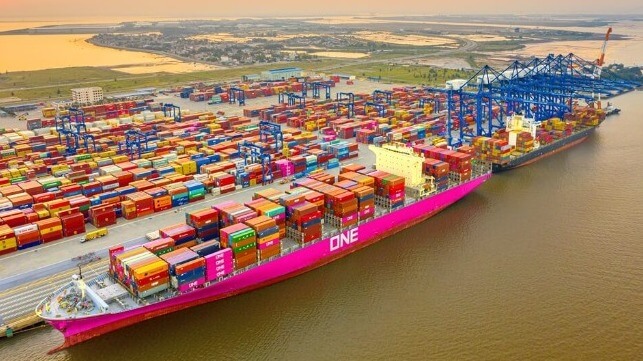
The Japanese shipyard Mitsui E&S shipbuilding has received an order for 30 cargo handling cranes for a customer in Vietnam. The procurement was made by the Port of Haiphong Joint Stock Company (CHP), a subsidiary of Vietnam Marine Corporation (VIMC), which is currently constructing the container terminal in the Lach Huyen area in Vietnam’s northern city of Hai Phong. The new port represents one of the first public-private partnerships between the Governments of Vietnam and Japan.
The order consists of six STS cranes and 24 RTGs. The STS cranes to be delivered have a 65-meter outreach and can be capable of handling large container vessels exceeding 15,000 TEU. This will be one of the largest crane orders for CHP for its port complexes in Haiphong area.
Mitsui has a record of delivering cargo handling cranes to CHP, with the last delivery made in 2007 as part of Japanese government’s official assistance to Vietnam. Japan International Cooperation Agency (JICA) is involved in the planning, design and construction of the new Lach Huyen Port.
Plans for the construction of Lach Huyen International Port were first launched in 2013 under Vietnam’s 2020 Seaport Development Plan. It is intended to be an extension of the Port of Haiphong, which over the years has seen a rise in demand for containerized cargo. The new terminal is designed to handle large container vessels, enabling direct exports from Northern Vietnam to the U.S and European markets without using transshipment ports in Singapore and Hong Kong.
The Lach Huyen Port is being developed on Cat Hai Island and connected by a sea bridge and access roads to mainland Vietnam. The port is being constructed in phases, and the first two container terminals have already been in operation since 2018.
The third and fourth terminals are still in construction and are expected to be commissioned by 2025, according to a statement in July by CHP. The procurement of the cargo cranes shows the works are on schedule.
Maersk is also working with Vietnam's HATECO to develop another two deepwater berths at Lach Huyen, capable of handing 18,000 TEU vessels. In the initial phase, the facility will have five STS cranes and 14 RTGs.
Greenock, Scotland Receives its Largest Boxship as Port Expands Trade
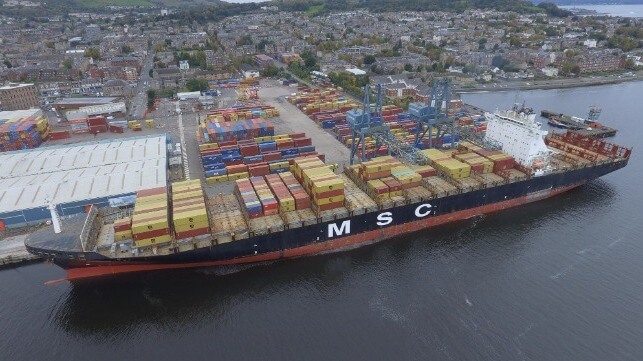
The Port of Greenock, Scotland’s deepest container terminal and the primary commercial port on the west coast, has received its largest containership to date breaking a six-year-old record. It is the latest demonstration of the container carriers upscaling their fleets even into second tier ports as the newest generation of ultra large boxships are making possible a rearranging across many routes.
The MSC Mangun VII arrived at the Port of Greenock at the end of last week on October 7. She was coming from Liverpool in England and continued to Portbury near Bristol before proceeding to Le Harve, France. Earlier on the route she had called in Antwerp.
At 85,832 dwt, she is a smaller containership with a capacity of 6,750 TEU. Built in 2003, the vessel which is registered in Liberia, is 984 feet in length. She however represents an increase for the port and on the feeder route on the West Coast of Scotland. The previous record for the largest containership to call in the port was the MSC Pohorje. That vessel was 875 feet in length with a capacity of 4,045 TEU, making her first visit to Greenock in July 2017.
“Containers are a big part of our offering at the Port of Greenock, so it was really special to welcome such an impressive container vessel to our port for the first time,” said Jim McSporran, Port Director, Peel Ports Clydeport. “It’s another proud milestone for everyone at the port, and reinforces the benefits of our central location, which makes us such a popular choice for customers looking to import and export their products into the UK and across Europe.”
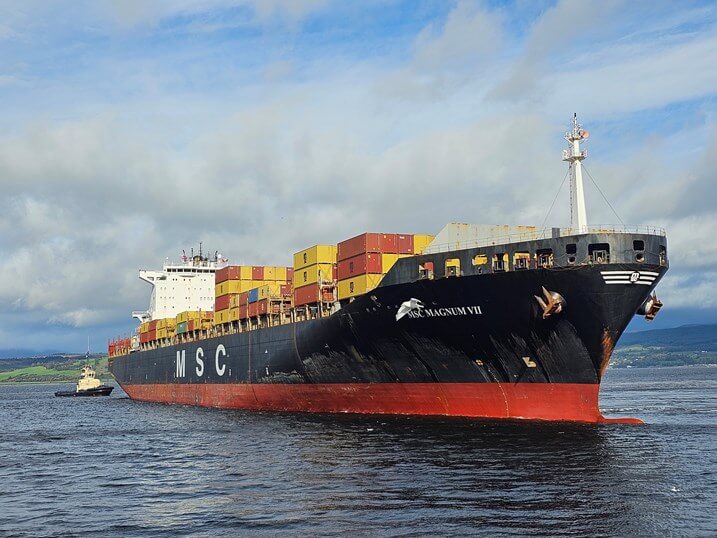
MSC Magnum VII arrived in Greenock on October 7 (Peel Ports)
The arrival of the larger containership is another step in the port operator’s efforts to expand trade at the port. Greenock currently handles a throughput of 100,000 TEU a year. They have recently ordered new, larger container cranes to expand the terminal’s handling capabilities. At a cost of £17 million ($20.7 million), the ship-to-shore cranes are the largest single investment made at the container terminal since it opened in 1969.
As a regional hub, the port looks to expand its trade broadly across multiple segments. Working with the Inverclyde Council, the Scottish and UK governments, Peel Ports is also expanding operations for the Greenock Ocean Terminal and a new visitor center designed to expand the cruise trade coming to the region.
While the port proudly marked the arrival of its largest containership, it was dwarfed by the largest vessel to call at the port, the MSC Virtuosa, a 181,500 gross ton cruise ship that is 1,0861 feet in length. She made her maiden call to the port in 2021 and returned in June 2023 as part of MSC’s summer 2023 deployment. She was part of an expected 150,000 cruise passengers projected for Greenock in 2023, which would represent the largest cruise total for the port.
Rotterdam, Antwerp and Zeebrugge Will Require Fuel Meters to Stop Cheating
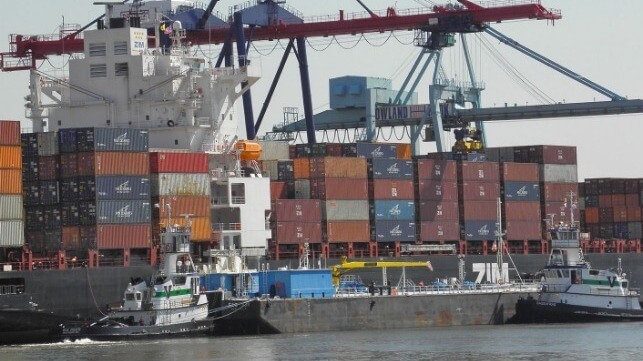
The port authorities for Rotterdam and Antwerp-Bruges are continuing to move forward with their efforts to make the bunkering markets in their ports more efficient and address long-standing concerns over cheating and shorting deliveries in the operations. The ports are moving forward announcing that they will make mass flow meters mandatory as of 2026 to address the issues in their markets.
At the end of 2022, the two port authorities announced they were working to address the long-standing issues and catch up with other ports around the world that had already instituted technologies to prevent these operational issues. According to the Dutch and Belgian ports, independent research has confirmed the recurring quality issues in the bunkering markets at Rotterdam, Antwerp, and Zeebrugge.
Starting January 1, 2026, operators in each of the ports will be required to have certified bunker measurement systems on board the fuel barges and bunker vessels. The system will indicate the exact amount of fuel that is being delivered to each seagoing vessel bunkering in these ports addressing the concerns about transparency, efficiency, and reliability.
The port authorities report that they expect this will have a “major impact on the bunker market.” They said that currently just 40 out of the 170 bunker vessels operating in Rotterdam, Antwerp, and Zeebrugge are equipped with a bunker measurement system.
They have spent the past few months consulting with the various stakeholders in the ports and working to develop a realistic roadmap to implement the new measurement systems across bunkering operations in the ports. They also reviewed the differing legal frameworks in Belgium and the Netherlands before proceeding with their plan.
The ports believe that by setting the start date as 2026, all the bunker operators will have sufficient time to adapt to the new measures. They note that Antwerp-Bruges has already begun including the requirement in the permits issued for bunkering vessels. The permit for bunker transporters in Rotterdam has not yet been updated.
The European ports are following the example of other major bunker markets that have already made meters mandatory. Singapore began the rollout of the technology five years ago and since then reports a dramatic improvement in the market.
Singapore also closely monitors the operations and audits the metering systems. They have identified attempts at cheating which have been met with strict penalties which can include canceling bunkering permits.
In 2021, a court in Singapore sentenced nine individuals to jail after the Maritime & Port Authority discovered in 2019 a cheating scheme during a routine audit of the systems. Similarly, in 2022 Singapore arrested ten men working as crew aboard two tugboats suspected of stealing fuel from their employer and selling it illegally in the market.
No comments:
Post a Comment